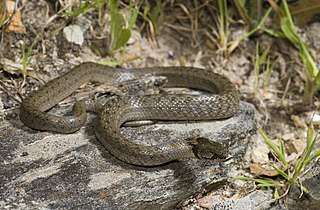
Spilotes sulphureus, commonly known as the yellow-bellied hissing snake or Amazon puffing snake, is a species of snake in the family Colubridae. The species is found in South America, as well as the Caribbean island of Trinidad.

Oxyrhopus petolarius, commonly known as the forest flame snake, is a species of snake in the family Colubridae. The species is endemic to South America. There are three recognized subspecies.

Trachischium is a genus of snakes, known commonly as slender snakes or worm-eating snakes, in the subfamily Natricinae of the family Colubridae. The genus is endemic to Asia.

The Colubrinae are a subfamily of the family Colubridae of snakes. It includes numerous genera, and although taxonomic sources often disagree on the exact number, The Reptile Database lists 717 species in 92 genera as of September 2019. It is the second largest subfamily of colubrids, after Dipsadinae. Many of the most commonly known snakes are members of this subfamily, including rat snakes, king snakes, milk snakes, vine snakes, and indigo snakes.
Macroprotodon abubakeri is a species of snake in the family Colubridae. It is one of four species in the genus Macroprotodon.

The western false smooth snake or Iberian false smooth snake is a species of snake in the family Colubridae.

Macroprotodon cucullatus, commonly known as the false smooth snake, is a species of mildly venomous colubrid snake endemic to the Mediterranean Basin.

Hoplocephalus is a genus of venomous snakes in the family Elapidae. The genus is endemic to Australia. Three species are recognized.

The twig snakes, also commonly known as bird snakes or vine snakes, are a genus of rear-fanged venomous snakes in the family Colubridae. The genus is native to Africa. All species in the genus have a slender and elongated profile, a long tail, a narrow head and a pointed snout. The eye of all species has a horizontal pupil, shaped like a keyhole, which gives twig snakes binocular vision. Twig snakes are greyish-brown with faint light and dark markings. When threatened, they inflate the throat to display bold black markings between the scales. Twig snake bites are potentially deadly: the venom is hemotoxic, affecting the blood clotting mechanism and causing uncontrolled bleeding and internal hemorrhaging. Bites by twig snakes have caused death in humans; famous herpetologist Robert Mertens died after being bitten by his pet savanna vine snake. However, envenomed bites are extremely rare when not handling the snake, as the fangs can't breach the skin except in a few places like the web between the thumb and fingers.

Oxyrhopus, the false coral snakes, is a genus of colubrid snakes that belong to the subfamily Dipsadinae. The genus is found in Central America and the northern part of South America, and it includes 15 distinct species.

Imantodes is a genus of colubrid snakes commonly referred to as blunt-headed vine snakes or blunt-headed tree snakes. The genus consists of seven species that are native to Mexico, Central America, and the northern part of South America.
Meizodon is a genus of snakes in the subfamily Colubrinae of the family Colubridae. The genus Meizodon contains five species, all of which are poorly known and are endemic to Sub-Saharan Africa.

Plagiopholis is a genus of snakes in the family Colubridae. The genus is native to Asia.

Compsophis is a genus of harmless snakes in the family Pseudoxyrhophiidae. The genus is found only on the island of Madagascar.

Uromacer is a genus of snakes in the family Colubridae endemic to the island of Hispaniola.
Stegonotus is a genus of snakes in the family Colubridae. Species of the genus Stegonotus are native to Australia, Indonesia, and New Guinea.

Ialtris is a genus of snakes in the subfamily Dipsadinae of the family Colubridae. The genus is endemic to the island of Hispaniola.
The smooth snake is a species of non-venomous snake found in northern and central Europe.
Pliocercus elapoides, also known commonly as the variegated false coral snake, is a species of snake in the family Colubridae. The species is native to southern North America and northern Central America. There are four recognized subspecies.














